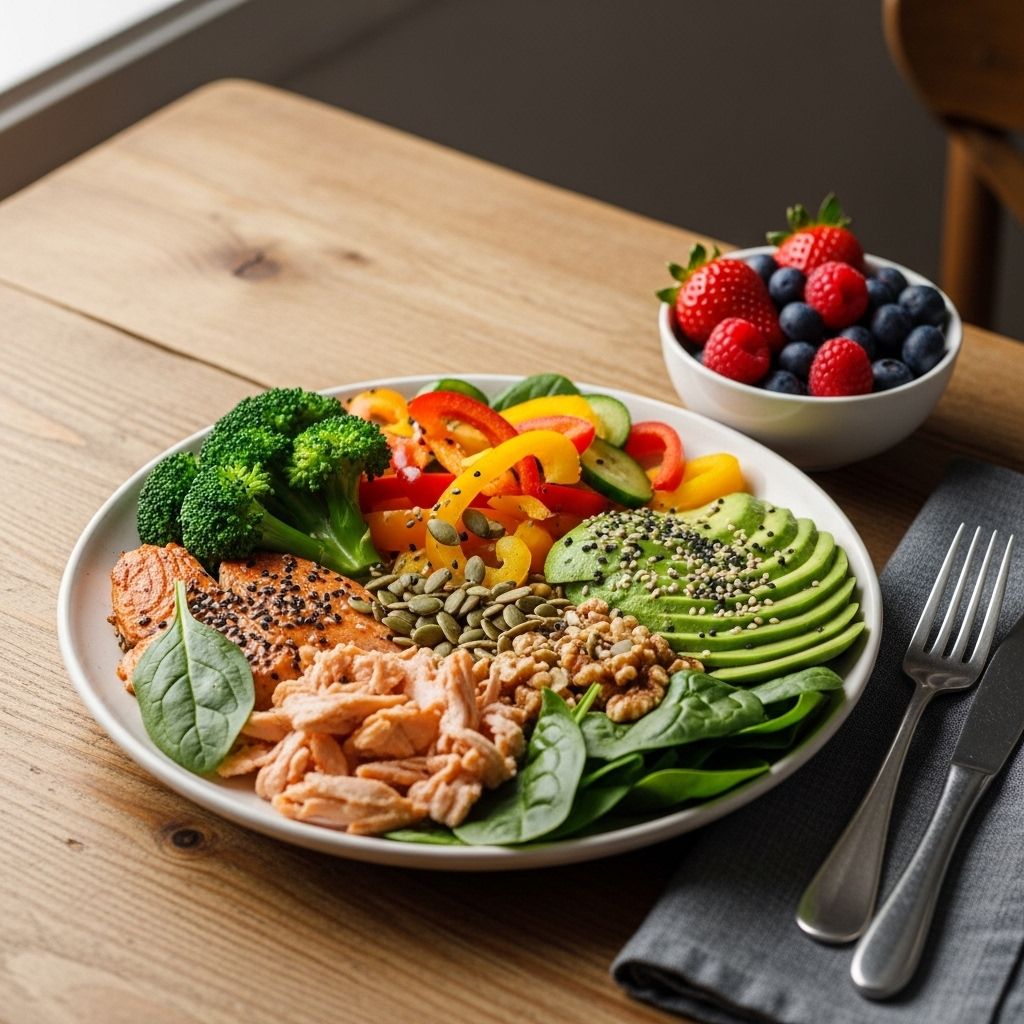The Pegan Diet: A Comprehensive Guide to the Paleo-Vegan Hybrid
Mixing plant-rich meals with quality proteins delivers balanced nutrients and energy.

The Pegan Diet: What Is It?
The Pegan diet is a nutritional approach proposed by Dr. Mark Hyman that combines the core philosophies of both paleo and vegan lifestyles. Instead of being rigidly carnivorous or entirely plant-based, the Pegan diet encourages an intentional mix—roughly 75% plant foods with 25% animal products—emphasizing whole, nutrient-dense, minimally processed ingredients. The diet is praised for its potential to reduce inflammation, balance blood sugar, and support overall health.
Philosophy: Combining Paleo and Vegan Principles
The Pegan diet draws from two popular dietary trends:
- Paleo: Focuses on eating foods believed to have been consumed during the Paleolithic era, including meat, fish, nuts, and vegetables, while excluding grains, legumes, refined sugars, and dairy.
- Vegan: Excludes all animal-derived products, prioritizing plants, fruits, vegetables, nuts, and seeds.
The Pegan diet merges these ideas, but allows select animal foods, low-glycemic fruits and vegetables, and limits processed items, dairy, gluten, grains, and legumes. It aims for sustainable practices and environmental consciousness.
The Pegan Diet Rules: Foods to Eat and Avoid
| Category | Foods to Emphasize | Foods to Limit or Avoid |
|---|---|---|
| Vegetables | Broccoli, carrots, peas, leafy greens, tomatoes (focus on low-starch, low-glycemic) | High-starch vegetables in excess |
| Fruits | Berries, apples, citrus (primarily low on glycemic index) | High-sugar fruits in large quantities |
| Nuts & Seeds | Almonds, walnuts, pistachios, chia, flax, pumpkin | Salted or heavily processed nuts & seeds |
| Animal Products | Grass-fed meats, pasture-raised eggs, wild-caught fatty fish (salmon, herring, cod) | Conventionally raised meats, processed deli meats |
| Grains | Small amounts of gluten-free grains (quinoa, brown rice, oats, amaranth) | Gluten-containing grains (wheat, barley, rye) |
| Dairy | None (dairy is excluded) | Milk, cheese, yogurt, ice cream |
| Processed Foods | Fresh foods, occasional natural sweeteners | Bread, pasta, cereals, baked goods, granola, beer, foods with artificial additives |
| Sugar | Occasional treats (minimal added sugars) | Refined sugars, sweets, sugar-sweetened beverages |
Key Takeaways
- Focus on whole, minimally processed ingredients.
- Prioritize foods high in phytonutrients, vitamins, and antioxidants.
- Limit additives, preservatives, artificial colors, and flavors.
- Emphasize sustainable and environment-friendly sourcing for animal products and produce.
Benefits of the Pegan Diet
- Balanced Nutrition: Combining diverse food groups offers a broad spectrum of essential nutrients.
- High Fiber: A plant-rich approach increases fiber intake, supporting digestive health, satiety, and weight management.
- Blood Sugar Regulation: Choosing low-glycemic carbs and avoiding refined sugars can stabilize blood glucose and reduce diabetes risk.
- Heart Health: Healthy fats, reduced processed foods, and fiber-rich ingredients may help lower cholesterol and heart disease risk.
- Reduced Inflammation: Minimizing processed foods and added sugars could lower systemic inflammation, improving overall well-being.
- Environmentally Conscious: Buying from local farmers and choosing sustainably raised proteins supports environmental stewardship.
Note: While many experts agree plant-based diets are linked to better health outcomes, the Pegan diet itself has not been extensively studied in clinical trials.
Potential Downsides and Considerations
- Risk of Nutrient Deficiencies: Excluding whole food groups—such as dairy, gluten grains, and legumes—can reduce certain nutrients (e.g., calcium, B vitamins).
- Accessibility and Cost: Sourcing organic produce and sustainably raised animal foods may be expensive or challenging, depending on location.
- Confusion and Restrictions: Adopting a new, hybrid diet may increase confusion around nutrition and create social or cultural challenges regarding food choices.
- Potential Lack of Whole Grains and Legumes: Many dietitians stress the health benefits of grains and legumes—important sources of fiber, vitamins, and minerals—which are minimized in the Pegan regimen.
- Questionable Necessity for Gluten and Dairy Elimination: If you do not have a clinical intolerance (such as celiac disease or lactose intolerance), omitting these foods may be unnecessary and even detrimental long-term.
Pegan Diet vs. Paleo vs. Vegan: A Comparison
| Feature | Pegan | Paleo | Vegan |
|---|---|---|---|
| Animal Products | Moderate, high-quality | Emphasized | Excluded |
| Plant Foods | Primary (75%) | Secondary (but included) | Primary (100%) |
| Grains | Limited—only gluten-free, infrequent | Excluded | Included (whole grains preferred) |
| Legumes | Some, in moderation | Excluded | Emphasized |
| Dairy | Excluded | Excluded | Excluded |
| Processed Foods | Minimized | Excluded | Minimized |
Sample Pegan Diet Menu
- Breakfast: Veggie omelet made with pasture-raised eggs, spinach, peppers, and tomatoes; side of berries.
- Lunch: Grilled wild-caught salmon salad with mixed greens, avocado, walnuts, and chia seeds; olive oil and lemon dressing.
- Snack: Sliced apple with almond butter; pumpkin seeds.
- Dinner: Grass-fed beef stir-fry with broccoli, snap peas, carrots, garlic, and ginger (served over a small portion of quinoa).
- Dessert (Occasional Treat): Coconut milk chia pudding sweetened with a touch of maple syrup.
This menu reflects balance, food variety, and nutrient density, while staying aligned with Pe…“` (truncated for brevity)
References
- https://www.nutrisense.io/blog/is-the-pegan-diet-good
- https://www.nkchealth.org/blog/the-pegan-diet-should-you-try-it
- https://www.healthline.com/nutrition/pegan-diet
- https://www.webmd.com/diet/pegan-diet-what-to-know
- https://health.clevelandclinic.org/pegan-diet
- https://pmc.ncbi.nlm.nih.gov/articles/PMC8325496/
- https://www.bestphysicaltherapistnyc.com/pegan-the-diet-of-the-moment/
- https://ific.org/resources/articles/what-is-the-pegan-diet-vegan-paleo-mashup/
Read full bio of medha deb












